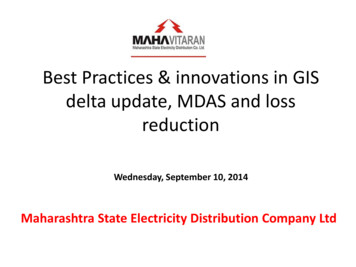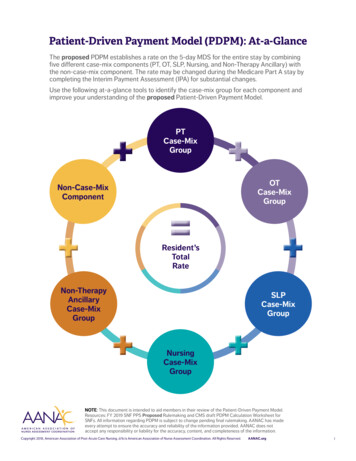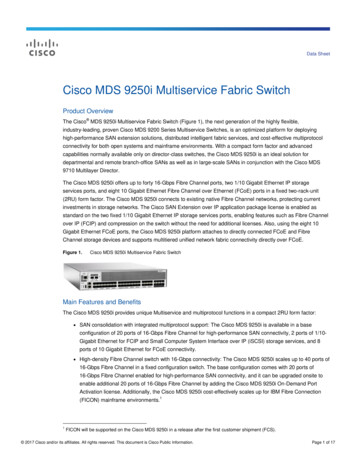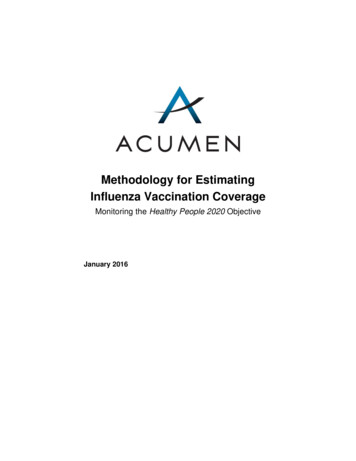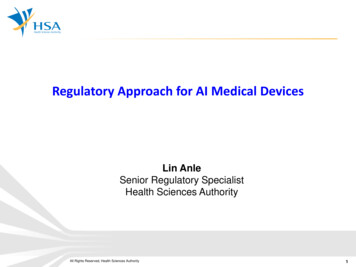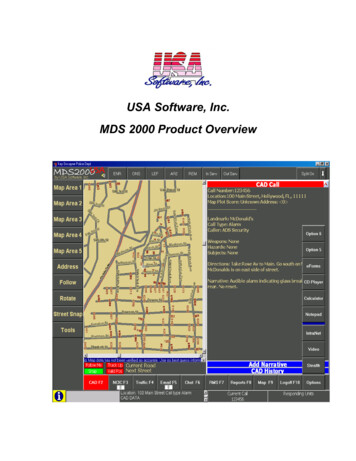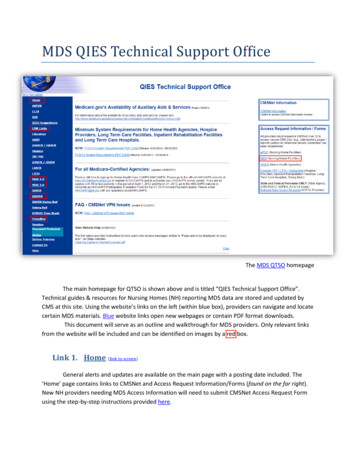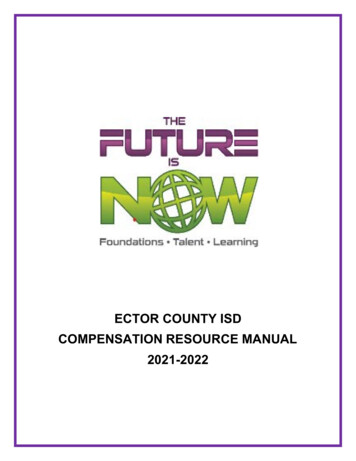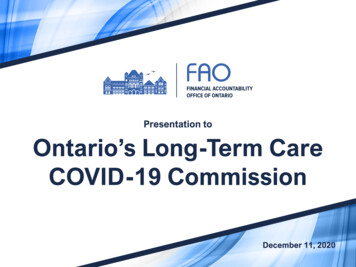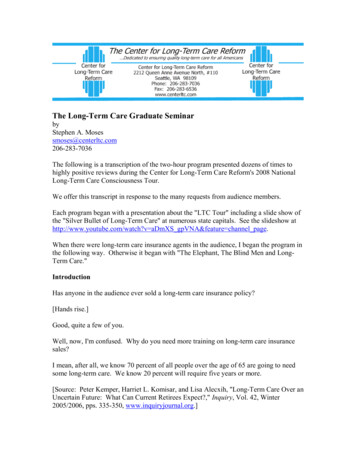
Transcription
Carol Maher, RN-BC, RAC-CTLong-Term CareMDS Coordinator’sField Guide
Long-Term CareMDS Coordinator’sField GuideCarol Maher, RN-BC, RAC-CT, RAC-MT, CPC
Long-Term Care MDS Coordinator’s Field Guide is published by HCPro, a division of BLR.Copyright 2016 HCPro, a division of BLRAll rights reserved. Printed in the United States of America.5 4 3 2 1ISBN: 978-1-55645-906-1No part of this publication may be reproduced, in any form or by any means, without prior written consent ofHCPro or the Copyright Clearance Center (978-750-8400). Please notify us immediately if you have received anunauthorized copy.HCPro provides information resources for the healthcare industry.HCPro is not affiliated in any way with The Joint Commission, which owns the JCAHO and Joint Commissiontrademarks.Carol Maher, RN-BC, RAC-CT, RAC-MT, CPC, AuthorOlivia MacDonald, EditorErin Callahan, Vice President, Product Development & Content StrategyElizabeth Petersen, Executive Vice President, HealthcareMatt Sharpe, Production SupervisorVincent Skyers, Design Services DirectorVicki McMahan, Sr. Graphic DesignerJake Kottke, Layout/Graphic DesignJason Gregory, Cover DesignerAdvice given is general. Readers should consult professional counsel for specific legal, ethical, or clinical questions.Arrangements can be made for quantity discounts. For more information, contact:HCPro100 Winners Circle Suite 300Brentwood, TN 37027Telephone: 800-650-6787 or 781-639-1872Fax: 800-785-9212Email: customerservice@hcpro.comVisit HCPro online at www.hcpro.com and www.hcmarketplace.com.
ContentsAbout the Author. viiThe Clinical Role of the MDS. 1Getting Started.3OBRA MDS Scheduling.7Types of Assessment (A0310). 8MDS 3.0 A to Z.19Section A . 19A0100: Facility Provider Numbers.24Section B .38Section C.41Section D. 48Section E.52Section F.66Section G.72Section GG. 90Section H.110Section I. 120Section J. 124Section K. 145Section L .160Section M.163Section N.193Section O. 198Section P.222Section Q. 227MDS as the Basis of Reimbursement (SNF PPS and Medicaid Case-Mix).239Reimbursement Role of the MDS 3.0.239Scheduling PPS Assessments.240 2016 HCProLong-Term Care MDS Coordinator’s Field Guideiii
LOA Affecting Scheduled PPS MDS.242ARD Outside the Medicare Part A SNF Benefit. 243Late MDS Assessment.244Census Events Affecting PPS.244Scheduled PPS Assessments .244Day of Admission.245Errors.245Late ARD After Payment Block.246Billing Default.246Missed Assessment. 247Unscheduled PPS Assessments. 247COT Impact on Billing. 251Therapy Software. 251Scheduled Assessments.254Don’t Forget the PPS Options.256PPS Windows.259How to Prevent Provider Liability.259First COT Observation Window.260Discontinuation of Therapy.260The RAI Manual Fine Print.262Possible Strategies (COT and Scheduled PPS).264COT and Discharge Assessment.266Documentation.268Section O0450.270EOT OMRA and Day of Discharge . 272Short-Stay Assessment. 273Calculating Therapy Minutes. 274Managing Multiple Specificities. 275Part A PPS Discharge Assessment. 277Care Area Triggers and Care Area Assessments. 281Triggering a CAA . 281Care Area Assessment .282The CATs and CAAs.287Delirium CAA.287Communication. 290ADL Functional/Rehabilitation. 290Urinary Incontinence and Indwelling Catheter CAA. 291Decision-Making and Care Planning.292Psychosocial Well-Being CAA.292ivLong-Term Care MDS Coordinator’s Field Guide 2016 HCPro
Mood State CAA.293Behavior CAA.294Activities CAA.294Falls CAA.295Nutritional Status CAA.296Feeding Tube CAA.297Dehydration/Fluid Maintenance CAA.297Dental Care CAA.298Pressure Ulcer CAA.299Psychotropic Medication Use CAA. 300Physical Restraints CAA. 301Pain CAA.302Return to the Community/Referral CAA.303MDS/RAI Process.304The MDS Correction Process: Modifications vs. Inactivations.307Errors and Corrections.307Modification or Inactivation. 310RN Attestation of Completion: X1000 Instructions.312Inactivation.316MDS 3.0 Quality Measures . 317Proposed Quality Measures: Improving Medicare Post-Acute CareTransformation (IMPACT) Act of 2014.317Episode vs. Stay. 318Five-Star Quality Measures.320New Short-Stay QM.330Surveyor Use Following QMs.349Payroll-Based Journal (PBJ).350New Quality Measures Affecting Nursing Home Compareand the Five-Star Quality Rating System.352SNF Quality Process Reporting Measures. 372 2016 HCProLong-Term Care MDS Coordinator’s Field Guidev
About the AuthorCarol Maher, RN-BC, RAC-CT, RAC-MT, CPC, is a board-certified gerontological registered nurse and acertified professional coder with over 30 years long-term care experience. She has worked in long-term carein many roles. Beginning as a nursing assistant, she later became a charge nurse, a nurse manager, andthen an RNAC/MDS coordinator. Maher has worked as an MDS coordinator since the early 1990s in a casemix state. Managing the case-mix and Medicare PPS processes was her specialty, along with ensuring theresidents were correctly assessed and resident-centered care was planned and provided.Recently, Maher was the senior VP of utilization services and director of reimbursement for large multi-facility organizations. In those roles, she taught MDS intensive classes, Medicare PPS assessment scheduling,and compliance with Medicare regulations. She assisted the California QIO, Lumetra, as their MDS expertfor two years.Maher has worked as one of the gold standard nurses for MDS 3.0. She also served on the CMS RAP workgroup as the chair for the New RAPS and Format committees. The CMS RAP work group provided inputto CMS to assist them to prepare the way for the CAAs for MDS 3.0. Maher also participated on a number of technical expert panels related to MDS, including the RTI technical expert panel to develop qualitymeasures for MDS 3.0 and the CMS TEP to improve care planning. A sought-after speaker, she has givenpresentations at AANAC, AHCA, and LeadingAge national conferences as well as many state organizationpresentations. She is also a frequent author of articles related to the RAI process and PPS.Maher served as a member of the AANAC (American Association of Nurse Assessment Coordination)board of directors for nine years. She is presently serving on the AANAC expert advisory panel and as anAANAC master teacher. Maher is the director of education for Hansen Hunter & Co., providing MDS andMedicare classes to the HHC clients. She also presents monthly educational webinars and completes compliance audits.She enjoys traveling and spending time with her family when not working. She is the proud mother ofthree amazing daughters who have all been professional ballet dancers and are now preparing for secondcareers in the healthcare industry. She is also the grandmother of four adorable grandchildren. 2016 HCProLong-Term Care MDS Coordinator’s Field Guidevii
Chapter 1The Clinical Role of the MDSThe Resident Assessment Instrument (RAI) was developed to help skilled nursing facility (SNF) staffmembers correctly assess residents and guide their clinical care. Providing care to postacute residents withcomplex comorbidities is challenging work. The RAI helps SNF staff members gather definitive informationon a resident’s strengths and needs, which must be addressed in an individualized care plan. The RAI iscomposed of three distinct parts: Minimum Data Set (MDS) Care Area Assessments (CAA) RAI Utilization GuidelinesIt is important to remember that the primary purpose of the MDS is to help the facility staff develop accurate, individualized care plans so that appropriate care will be provided. This means that the MDS coordinator and interdisciplinary team (IDT) members who complete the MDS assessments are care managersfor the residents in long-term care. Accurate assessment is crucial for correct care of the residents. After anaccurate MDS has been completed, the clinical team must use their critical-thinking skills to determine theroot cause of the residents’ problem areas, using the CAAs to guide their future care plans.The MDS uses a snapshot view of the residents’ functional, cognitive, psychosocial, and clinical status. Byusing the same instructions for capturing the residents’ status on each MDS, the facility clinical team canlook at each consecutive (required to be reassessed by regulatory timed intervals) MDS response to determine whether the residents have improved or declined.The MDS coordinator functions as the leader/coordinator of the RAI process. The RAI process requires thereview of a resident’s entire medical record with a specific focus on the MDS snapshot (look-back window), 2016 HCProLong-Term Care MDS Coordinator’s Field Guide1
Chapter 1scripted and unscripted interviews of the residents, interviews of the direct care staff members who care forthe resident, and cooperation with the entire IDT to develop an individualized care plan.Quality Measures (QM) are calculated from the MDS data that have been collected and transmitted to thefederal database. These QMs show how the facility compares to other SNFs in the United States. Facilitiesshould use this information to refocus their quality improvement efforts, as necessary.The Care Area Assessment (CAA) process is the link between the MDS data collection and the individualized resident care plan. The MDS team must use their critical-thinking skills to get to the root cause of theissue and to determine whether a care plan is required.This CAA decision-making process is designed to assist the assessor to systematically interpret the information recorded on the MDS. Once a care area has been triggered, nursing home providers use current,evidence-based clinical resources to conduct an assessment of the potential problem and determine whether a care plan is required. The CAA process helps the clinician focus on key issues identified during theassessment process so that decisions as to whether and how to intervene can be explored with the resident.The MDS data collection reports whether the issue happened, and the CAAs help the MDS team determinethe cause of the issue and whether it is problematic to the resident.The RAI process has multiple regulatory requirements. Federal regulations at 42 CFR 483.20 (b)(1)(xviii),(g), and (h) require that:1. The assessment accurately reflects the resident’s status2. A registered nurse conducts or coordinates each assessment with the appropriate participation ofhealth professionals3. The assessment process includes direct observation, as well as communication with the residentand direct care staff on all shiftsNursing homes are left to determine:4. Who should participate in the assessment process5. How the assessment process is completed6. How the assessment information is documented while remaining in compliance with the requirements of the federal regulations and the instructions contained within the manualSuccessfully utilizing the RAI will lead to an effective, individualized care plan and optimal care for the resident. Optimal care for the residents should result in good QMs and lead the way to good survey outcomesand accurate reimbursement for the services that have been provided. The RAI leads the assessors to get toknow the resident as a whole person with unique strengths and needs. Understanding the residents’ needsand choices should lead to a higher quality of care and, therefore, a better quality of life.2Long-Term Care MDS Coordinator’s Field Guide 2016 HCPro
The Clinical Role of the MDSGetting StartedWhether you are just beginning your career or are a veteran MDS coordinator, you play a pivotal role inmanaging the long-term care residents’ care. The MDS coordinator role is vital to: Accurate care planning QMs Accurate reimbursement from state and federal fundsThe resource utilization group (RUG) from the prospective payment system (PPS) MDS assessments alsoprovides the basis for Medicare payment. MDS coordinators play a crucial role as a member of the facility’sMedicare team. By understanding the Medicare regulations and Medicare coverage rules, the MDS coordinator can assist the clinical team to make decisions that will provide the resident with appropriate Medicarecoverage and ensure that the SNF is working within the regulatory guidelines.The following tools will aid you during your MDS coordinator journey, including: The RAI MDS 3.0 User’s Manual: This manual is an absolute must-have for MDS coordinators. TheRAI MDS 3.0 User’s Manual contains the Centers for Medicare & Medicaid Services (CMS) instructions for coding the MDS. It is crucial that you have the most updated version. CMS updates themanual at least annually, typically in October. Having a hard copy of the manual is nice, becauseyou can then highlight important text and write notes in the margins. You can download a copyfor free from the CMS website: www.cms.gov. Enter “MDS 3.0” in the search box and hit enter. Youshould be guided to the MDS portion of the CMS website. Scroll down and find the most updatedversion. Most MDS software also includes links to the RAI manual. Hard copies of the MDS forms (item sets): These copies can be used in case of internet or software issues. They are also helpful to review when learning the process. It is easier to see the skippatterns when looking at the item sets. You can purchase MDS forms; some of the purchased formshave payment items highlighted and CAA triggers listed. You can also download the most updatedMDS item sets from the CMS website for free. MDS interview cue cards: It is important to have cue cards available for the residents during theMDS resident interviews. It is helpful to have a set that is laminated so that it can be wiped off afterthe resident points to the answer on the cue card during the interview. It can also be helpful to printeach different set of cue cards in a pastel color. I think it is easier for older eyes to see the black printon light-colored paper than on stark black and white. Each one of your IDT members will need theirown set of cue cards. Portable hearing amplifier (pocket talker): In order to ensure that your residents can hear the interview questions, it is helpful to have a portable hearing amplifier available for them to use. Hearing 2016 HCProLong-Term Care MDS Coordinator’s Field Guide3
Chapter 1amplifiers are available in larger discount and electronic stores or on the internet. Consider infection control guidelines when choosing a model. MDS software: Your facility should have MDS software where you will enter data from the MDSassessments and transmit them to the federal database. You will need time to learn how to use thesoftware system. Specific areas to focus on include how to: ––Create new assessments––Set assessment reference dates (ARD)––Modify an MDS when an error occurs––Find the MDS scheduler––Print the forms––Sign the forms for accuracy and for completion––Batch the forms to prepare for transmission––Transmit––Mark
Minimum Data Set (MDS) Care Area Assessments (CAA) RAI Utilization Guidelines It is important to remember that the primary purpose of the MDS is to help the facility staff develop accu-rate, individualized care plans so that appropriate care will be provided. This means that the MDS coordi-
